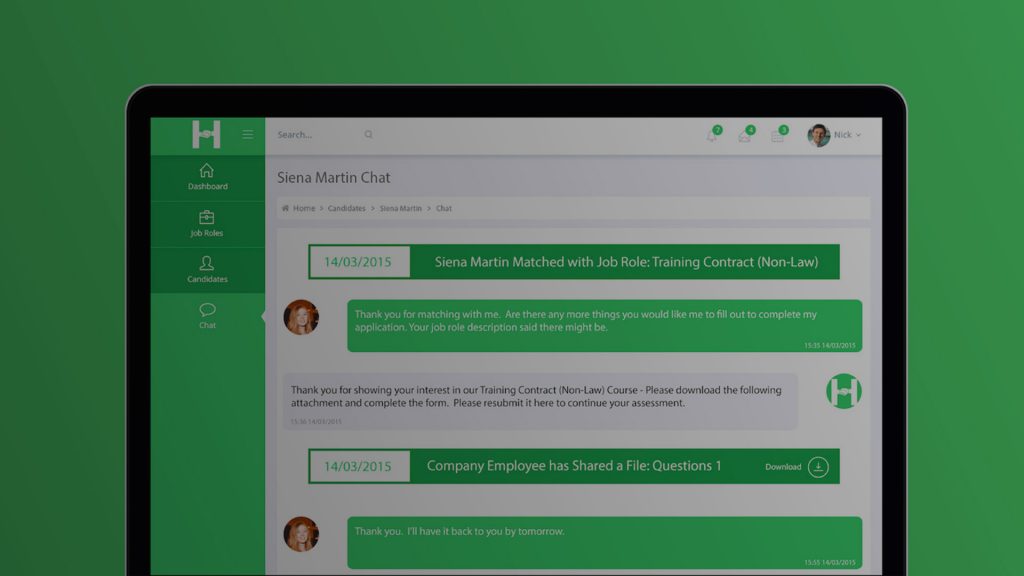Key Takeaway
The recruitment and HR industry is due for a massive shakeup, and it’s the perfect use case for the latest machine learning technology. Companies like Headstart are leveraging external data to change the recruitment experience for both employers and job seekers, in an effort to ensure candidates will be placed in the best role for them – leading to successful teams with motivated employees down the road.
Nicholas Shekerdemian and Jeremy Hindle founded HR tech company Headstart in 2015, after Nicholas noticed a massive pain point when trying to find an internship after graduating from Oxford University.
Today, the platform uses advanced machine learning and predictive analytics to improve the hiring process both for hiring teams and for the candidate. After graduating from the Y Combinator 2017 batch, Headstart went on to raise significant support from investors and clients in both the UK and the US. Nicholas and Jeremy also landed on this year’s Forbes 30 Under 30 social entrepreneurs list.
We spoke with Co-Founder and CTO Jeremy Hindle for the story behind Headstart, and his take on the future of HR tech.
What is Headstart and who is it for?
Headstart analyses candidates at the point of application, streamlining the recruitment process for both the candidate and hiring company, and helping job seekers find roles that are more closely aligned to their personality, motivations, experience and values.
The product becomes the front end of a company’s recruitment process. “Traditionally, this is served by an ATS (applicant tracking system). We call ourselves an AMS – an applicant matching system – with machine learning and automation capabilities.”
Headstart tells employers who the best candidates are for open positions, based on match scores they create between each candidate and the particular job opening. “Then, because we have details for every candidate on our platform, we can reach out to those that got rejected and say, ‘We’re really sorry you were unlucky. Here are some roles where you’re actually a really strong match for and would fit perfectly. Apply here with one click.’”
The process starts by mapping the company’s unique culture, using data collected from existing members of the organization via a questionnaire and psychometric assessment. Based on their answers to questions including ‘What are the hard skills you use to perform your job on a day to day basis?’ and ‘Please describe your perfect colleague’, Headstart will segment the organization by department (working group), performance and level of seniority, then by low performing and high performing members.
“In every department, there’s almost always at least 3 micro-clusters within a group. When we map candidates across to those people, we can measure the distance they are from each of those clusters, and give them scores accordingly.”
The team additionally incorporates external data from scientific studies which look at complementary traits. “If these people are high performance, and they have similar interests to a candidate that doesn’t have those same traits, but has very complementary traits, for instance, they’ll also score highly.”

According to Jeremy, it’s not about hiring a lot of the same people; it’s about building teams that work well together. “In a creative team, for instance, you never want less than 4 introverts because they won’t contribute; they won’t feel there are enough in the room. During the hiring process the match scores will change over time, taking this into account.”
Why the recruitment industry is due for a shake-up
“Today it can take anywhere from 4 hours to a week for successful candidates to find a position coming out of uni. The process is not candidate-centric, and they often don’t know what they’re applying for.”
Jeremy notes that many candidates try to tailor their CVs toward what they think a particular company wants to hear, making it difficult for the hiring manager to differentiate and obscuring the candidate’s true profile. “It’s very unlikely that a student actually knows what that job entails. So they portray themselves as what they think a company wants to hear, and as a result this makes them look the same as every other candidate.”
Today Starbuck’s gets 26k applications a day. Accenture had over 106k applicants in the last 3 months for two roles. They can hire a fraction of that. When looking at several thousand applications, it’s too much information for a human to digest; the help of AI and predictive analytics has become essential.
“How can you expect 3 graduate recruiters to go through 100k students in a fair way? It’s just not possible. They cant, really. They’re just filtering CVs; they’re not looking at candidates as people. We’re going to be able to change that.
“Every successful startup says recruitment is the hardest and most important element for their growth. But in all these large businesses it comes last in decision-making tree. We will empower recruiters to focus on finding the perfect candidate, so they can spend more time with the right candidates, making sure they feel on-boarded and like they fit in with the company.”
A lot of students don’t know what they want to do when they leave university. As well, I think in London a lot of people are just going through the motions. You’re spending the majority of your life at work. If I could make more people love their jobs, that would be great.
Turning the process on its head: the candidate-first experience
Many in the HR space today are focused on improving the experience for the candidate, which will help them find a much better fit and ultimately decrease the number of applications a job seeker submits. According to Jeremy, this includes giving them more control and flexibility over their application and allowing them to better demonstrate their skills.
“We have always taken a candidate-centric approach. Everything we do is driven toward making that experience as good as possible.” The first step? Improving the CV passer.
“We have a specific algorithm that looks at work experience and then pulls the text out to understand what the candidate actually did – their hard and soft skills. A lot of CV passers do this, but they are abysmal today. The industry-leading one is less than 60% accurate. As well, the candidate doesn’t even get to check what’s pulled out.” Headstart, in contrast, allows the candidate to confirm or edit information pulled by the initial pass.
Does the CV still have a place?
“I don’t think it’s going anywhere super soon, but I’d like it to disappear immediately. We did analysis looking at people’s CVs and what they wrote for work experience. Some wrote about responsibilities, some wrote what they learnt; some wrote a mixture of that. People don’t structure that section particularly well because they’re not guided to. And they’re customizing it per company, which means it’s not even representing what actually happened.”

External data: the metrics that make a difference
“By definition, most of our insights are external. The only internal data we use is in that first questionnaire – the line in the sand. It’s crucial to measure the line of where we start as accurately as possible, to use that as a baseline for where we want to go. All candidate data is external – it comes from the candidate and public sources.”
Jeremy discusses the concept of the opportunity coefficient, a metric he’s used in creating Headstart to help inform candidate match scores: “Every candidate at every point in their life in the past has had a certain amount of opportunity available to them – based on where they live, how much their parents earn, what jobs their parents have, where they went to school, race, gender. I have this theory that overachievement shouldn’t be measured on a single point but as a steadily increasing gradient of their opportunity.”
Results: success by the numbers
According to the Headstart team, their AI has reduced time spent viewing candidates by 70%, and reduced time job seekers spent applying to 15 minutes. Their biggest success, according to Jeremy, is improved diversity.
In a recent case study, Headstart found significant data that supports improved diversity: a leading consulting firm found 30% reduction in bias toward black candidates and 15% reduction in bias toward Asian candidates, just in the screening process, using Headstart. (*This includes 30% of data so far but indicates a strong correlation.)
Headstart by the numbers
The executive of the future and tomorrow’s recruitment process
Jeremy believes machine learning will have a massive impact on ethics around executive decision-making in the future, and he stresses the importance of understanding assumptions behind any decisions that are being facilitated by AI.
“Having a strong understanding of what data goes into your algorithms should inform you enough as to whether your algorithms are trustworthy….All of the compounding factors are undoubtedly there – every set of data is biased in one way or another; you can only lessen it. You have to ask, ‘does this take into account as much information about all the people it affects as possible?’ That’s something we think about literally everyday here.”

